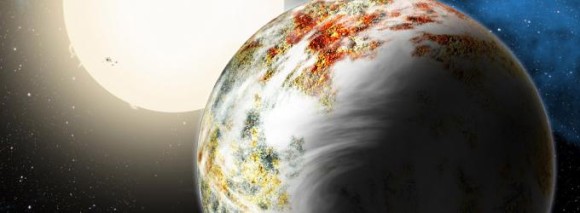
Astronomers have discovered a new type of planet – a rocky world weighing 17 times as much as Earth. Theorists believed such a world couldn’t form because anything so hefty would grab hydrogen gas as it grew and become a Jupiter-like gas giant. This planet, though, is all solids and much bigger than previously discovered “super-Earths.” Astronomers are using the term “mega-Earth” to describe this new, large, rocky type of world. The team presented these findings today (June 2, 2014) in a press conference at a meeting in Boston of the American Astronomical Society.
Astronomer Xavier Dumusque of the Harvard-Smithsonian Center for Astrophysics (CfA) led the data analysis and made the discovery. Another CfA astronomer, Dimitar Sasselov, director of the Harvard Origins of Life Initiative, said:
This is the Godzilla of Earths! But unlike the movie monster, Kepler-10c has positive implications for life.
The newfound mega-Earth, Kepler-10c, circles a sunlike star once every 45 days. It is located about 560 light-years from Earth in the direction of the constellation Draco the Dragon. The discovery that Kepler-10c is a mega-Earth has profound implications for the history of the universe and the possibility of life, astronomers say.
That’s because the Kepler-10 system is about 11 billion years old, which means it formed less than 3 billion years after the Big Bang. The early universe contained only hydrogen and helium. Heavier elements needed to make rocky planets, like silicon and iron, had to be created in the first generations of stars. When those stars exploded, they scattered these crucial ingredients through space, which then could be incorporated into later generations of stars and planets.
This process should have taken billions of years. However, Kepler-10c shows that the universe was able to form such huge rocks even during the time when heavy elements were scarce. Astronomer Sasselov said:
Finding Kepler-10c tells us that rocky planets could form much earlier than we thought. And if you can make rocks, you can make life.
This research implies that astronomers shouldn’t rule out old stars when they search for Earth-like planets. And if old stars can host rocky Earths too, then we have a better chance of locating potentially habitable worlds in our cosmic neighborhood.
Astronomers believe that more mega-Earths will be found.
Read more about Kepler-10c – the “mega-Earth” planet – at CfA











